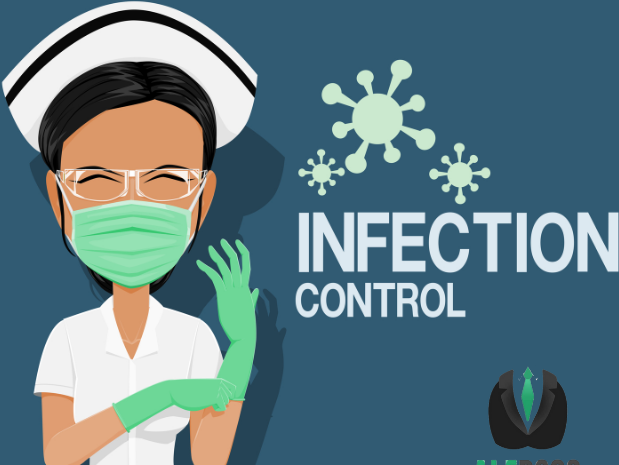 As we all know that proper practice infection control in nursing is so vital as it is not only protecting patient, staff from infection, but also reducing the financial drainage from the healthcare system as well as destroying the healthcare reputation.
As we all know that proper practice infection control in nursing is so vital as it is not only protecting patient, staff from infection, but also reducing the financial drainage from the healthcare system as well as destroying the healthcare reputation.
Indeed, overlooking infection control practices in nursing is seriously affecting patient safety. An obvious example of common infection in the hospital setting is healthcare-associated infections such as MRSA or C. difficile. The consequences of these infections even worsen in vulnerable elderly or patients with a weakened immune system.
These infections are not only affecting patients but also nurses and healthcare workers who can find themselves exposed to a whole array of infectious agents, especially if protective equipment is not properly taking part of their daily get-up. Staff’s health matter is at risk even though just skipping donning gloves, mask or goggles in their daily shifts.
Moreover, infection affects financial matter too! Treating infections is expensive, it is a massive drain on hospital resources. The patients are talking longer hospital stays, pricey medications, and other costs related. That money could be better spent on resources or training for healthcare team.
Apart from that, infection destroys facility’s reputation. Patients want to go to great hospital reputations with excellent infection control protocol to keep them safe.
Therefore, overlooking infection control is not minor oversight in nursing, it is a risk nobody can afford to take. Keeping everyone informed and equipped isn’t only wise, but also essential for safety despite the complexity of the healthcare system.
Why Infection Control Lapses Occur: Identifying the Root Causes
Managing infection control is a huge matter, we are all know that it is a big issue in healthcare environment, but it has still happened, why? There are variety of causes from improper hand hygiene, dismissing personal protective equipment (PPE), to lack of education, time constraints or overconfident from senior staffs and lastly lack of communication amongst others.
We are nurses often face heavy workloads. When we are lacking vigilance, vital steps such as hand hygiene or equipment sterilization might be missed. It is too easy to skip a step when juggling priorities.
Another huge matter is the lack of training or updated education. If nurses aren’t fully trained in infection prevention methods, those crucial steps might accidentally fall through the cracks. Regular training is a must to keep up with the latest in infection control.
And then, sometimes the bare essentials like gloves or disinfectants aren’t readily available. Seriously, how can anyone follow protocol without having the right tools? It is crucial that all necessary supplies are always at hand.
Another matter is working under tight time constraints is also a major factor. When nurses are racing against the clock, there’s a temptation to cut corners. But every hand wash and sanitization count and finding that few extra seconds can mean everything.
Furthermore, there’s also the danger of overconfidence. There are some senior staff might start thinking they can spot who’s infectious and who’s not, which leads to inconsistent practices. But the reality is, infections don’t show up in bold headlines, and assuming so is so risky.
Lastly, communication breakdowns lead to issues. When healthcare workers aren’t on the same page about infection risks, important steps can be skipped. Clear, open communication is not only being polite but making all the difference.
Proactive Strategies for Enhancing Infection Control Practices
Keeping up with infection control in nursing is a team effort, and that means embracing ongoing education and training. Regular refresher courses can ensure everyone is up to date all the latest pathogens and control tactics. Learning continues once you’re on the job; it’s an ongoing process.
Staffing levels need serious attention too. Adequate nurse-to-patient ratios aren’t only numbers, but also, they’re about preventing burnout and allowing nurses the time and energy to adhere to infection control protocols. Less stress equals more diligence, and perfection in protocol compliance.
Having easy access to personal protective equipment (PPE) and sanitation supplies is also vital. When everything a nurse needs is just a reach away, the excuses for not following procedures quickly vanish. It’s a simple step that can prevent costly consequences.
Fostering a culture of safety is probably one of the most underrated strategies. Open lines of communication and fostering a sense of accountability across all levels create an environment where infection control is everyone’s responsibility, not just handed off to someone else.
Regular audits and feedback are like the compass that keeps us pointed in the right direction. Evaluating current infection control practices and providing constructive feedback can keep complacency at bay and inspire continuous improvement. It’s learning from findings to bolster defense against infections.
Understanding the Consequences of Non-Compliance
Letting infection control standards slide is a huge risk. Healthcare facilities are bound by legal requirements to meet specific infection control standards and fail to maintain it leads to the risk of losing accreditation.
The direct consequences on patient outcomes are even more severe. Acquiring an infection in a healthcare setting can lead to increased morbidity and mortality rates, leaving patients with worsened conditions and a longer road to recovery. Therefore, do not underscores the importance of rigorous infection control.
This implication does not stop at the hospital doors. Outbreaks can spread into the community, causing a major effect that poses a broader public health risk. This community spread can exacerbate public health issues, making it clear that infection control is a safeguarding the public at large.
Addressing these lapses is not a single approach. A mix of education, resource allocation, and cultivating an environment rooted in safety is essential. By prioritizing these areas, healthcare facilities can step up, transforming infection control from a daunting challenge into a manageable priority.
